You are here
When wonders meet: Petra and Great Wall of China forge global alliance
By Sophie Constantin - May 22,2025 - Last updated at May 22,2025

The agreement marks a new chapter in cultural diplomacy, bringing together two of the world’s most iconic heritage sites (Photos by Ahmed Khlifat)
PETRA — The ancient city of Petra hosted a historic event on Tuesday as it welcomed a high-level Chinese delegation for the signing of a twinning agreement between Petra and Jiayuguan City, home to the Great Wall of China.
The agreement marks a new chapter in cultural diplomacy, bringing together two of the world’s most iconic heritage sites in a strategic partnership to promote international tourism, exchange, and cooperation.
The ceremony, held in front of Petra’s Treasure, was led by Fares Braizat, Chief Commissioner of the Petra Development and Tourism Region Authority, Zhao Shumin, Director of the Culture and Tourism Bureau of Jiayuguan Municipality, and was attended by Chen Chuandong, Chinese Ambassador to Jordan, as well as representatives from Jordan’s tourism and local development sectors.
“This is a historical moment,” Braizat said, “We are not just connecting two landmarks – we are connecting two great cultures from the Middle East and East Asia. This partnership promotes dialogue, fosters mutual respect, and raises global awareness of the values we share.”
The agreement outlines a roadmap for collaboration in tourism marketing, cultural exchange, education, investment, and joint events. It includes plans for hosting exhibitions, supporting community-based initiatives, and sharing expertise in heritage preservation, traditional industries, and crafts.
Ambassador Chen highlighted the broader significance of the partnership : “Jordan has long stood at the crossroads of civilisations. By uniting Petra and the Great Wall, we celebrate peace, prosperity, and humanity’s shared legacy. We hope to see more Chinese tourists walking through the wonders of Petra.”
This initiative follows a growing trend by the Petra authority to build global cultural bridges : similar twinning agreements have already been signed with the Colosseum in Rome and the Alhambra in Grenada, all aimed at reinforcing Petra’s position as a global tourism hub.
Petra, a masterpiece of Nabatean architecture carved into rose-red rock more than 2,000 years ago, remains a symbol of resilience, trade, and intercultural exchange. Likewise, the Great Wall, an architectural marvel and strategic fortress at the edge of China’s ancient Silk Road – stands as a testament to China’s imperial ingenuity and historic connectivity with the West.
“This agreement will enhance the Great Wall’s standing on the global tourism map while creating exciting new opportunities for Petra in the Chinese market,” Zhao Shumin said. “It opens the door to long-term cooperation rooted in cultural appreciation and mutual respect.”
As two marvels of ancient civilization join hands in a modern pact, the Petra-Jiayuguan partnership sets a new precedent for how heritage sites can collaborate across borders – not just to attract visitors, but to inspire cultural understanding in a deeply interconnected world.






















